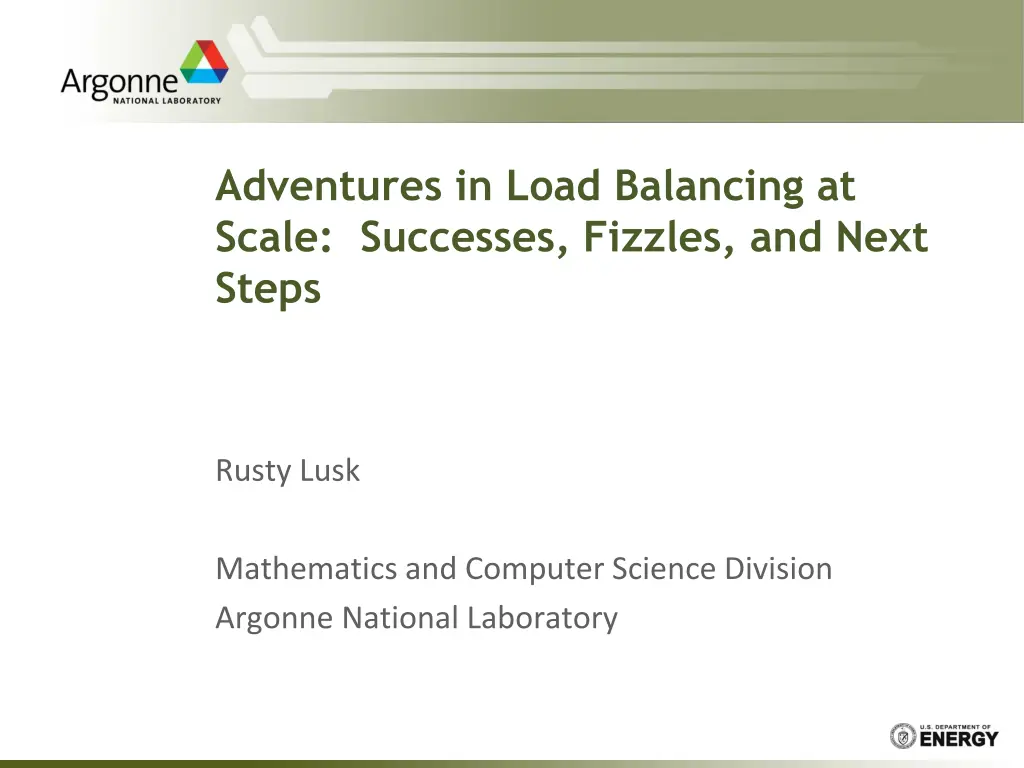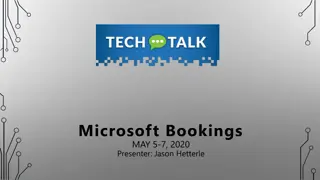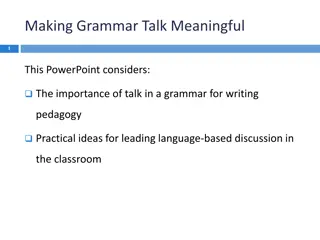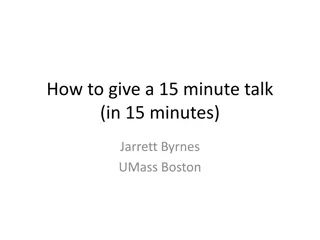
Load Balancing at Scale: Successes, Fizzles, and Next Steps
Explore the adventures in load balancing at scale, successes, and future directions outlined by Rusty Lusk from Argonne National Laboratory. Learn about parallel programming models, load balancing fundamentals, and the Greens Function Monte Carlo application in nuclear physics.
Download Presentation

Please find below an Image/Link to download the presentation.
The content on the website is provided AS IS for your information and personal use only. It may not be sold, licensed, or shared on other websites without obtaining consent from the author. If you encounter any issues during the download, it is possible that the publisher has removed the file from their server.
You are allowed to download the files provided on this website for personal or commercial use, subject to the condition that they are used lawfully. All files are the property of their respective owners.
The content on the website is provided AS IS for your information and personal use only. It may not be sold, licensed, or shared on other websites without obtaining consent from the author.
E N D
Presentation Transcript
Adventures in Load Balancing at Scale: Successes, Fizzles, and Next Steps Rusty Lusk Mathematics and Computer Science Division Argonne National Laboratory
Outline Introduction Two abstract programming models Load balancing and master/slave algorithms A collaboration on modeling small nuclei The Asynchronous, Dynamic, Load-Balancing Library (ADLB) The model The API An implementation Results Serious GFMC: complex Monte Carlo physics application Fun Sudoku solver Parallel programming for beginners: Parameter sweeps Useful batcher: running independent jobs An interesting alternate implementation that scales less well Future directions for the API yet another implementation 2
Two Classes of Parallel Programming Models Data Parallelism Parallelism arises from the fact that physics is largely local Same operations carried out on different data representing different patches of space Communication usually necessary between patches (local) global (collective) communication sometimes also needed Load balancing sometimes needed Task Parallelism Work to be done consists of largely independent tasks, perhaps not all of the same type Little or no communication between tasks Traditionally needs a separate master task for scheduling Load balancing fundamental 3
Load Balancing Definition: the assignment (scheduling) of tasks (code + data) to processes so as to minimize the total idle times of processes Static load balancing all tasks are known in advance and pre-assigned to processes works well if all tasks take the same amount of time requires no coordination process Dynamic load balancing tasks are assigned to processes by coordinating process when processes become available Requires communication between manager and worker processes Tasks may create additional tasks Tasks may be quite different from one another 4
Greens Function Monte Carlo A Complex Application Green s Function Monte Carlo -- the gold standard for ab initio calculations in nuclear physics at Argonne (Steve Pieper, PHY) A non-trivial master/slave algorithm, with assorted work types and priorities; multiple processes create work dynamically; large work units Had scaled to 2000 processors on BG/L a little over four years ago, then hit scalability wall. Need to get to 10 s of thousands of processors at least, in order to carry out calculations on 12C, an explicit goal of the UNEDF SciDAC project. The algorithm threatened to become even more complex, with more types and dependencies among work units, together with smaller work units Wanted to maintain master/slave structure of physics code This situation brought forth ADLB Achieving scalability has been a multi-step process balancing processing balancing memory balancing communication 5
The Plan Design a library that would: allow GFMC to retain its basic master/slave structure eliminate visibility of MPI in the application, thus simplifying the programming model scale to the largest machines 6
Generic Master/Slave Algorithm Shared Work queue Master Slave Slave Slave Slave Slave Easily implemented in MPI Solves some problems implements dynamic load balancing termination dynamic task creation can implement workflow structure of tasks Scalability problems Master can become a communication bottleneck (granularity dependent) Memory can become a bottleneck (depends on task description size) 7
The ADLB Vision No explicit master for load balancing; slaves make calls to ADLB library; those subroutines access local and remote data structures (remote ones via MPI). Simple Put/Get interface from application code to distributed work queue hides MPI calls Advantage: multiple applications may benefit Wrinkle: variable-size work units, in Fortran, introduce some complexity in memory management Proactive load balancing in background Advantage: application never delayed by search for work from other slaves Wrinkle: scalable work-stealing algorithms not obvious 8
The ADLB Model (no master) Slave Slave Slave Slave Slave Shared Work queue Doesn t really change algorithms in slaves Not a new idea (e.g. Linda) But need scalable, portable, distributed implementation of shared work queue MPI complexity hidden here 9
API for a Simple Programming Model Basic calls ADLB_Init( num_servers, am_server, app_comm) ADLB_Server() ADLB_Put( type, priority, len, buf, target_rank, answer_dest ) ADLB_Reserve( req_types, handle, len, type, prio, answer_dest) ADLB_Ireserve( ) ADLB_Get_Reserved( handle, buffer ) ADLB_Set_Done() ADLB_Finalize() A few others, for tuning and debugging ADLB_{Begin,End}_Batch_Put() Getting performance statistics with ADLB_Get_info(key) 10
API Notes Return codes (defined constants) ADLB_SUCCESS ADLB_NO_MORE_WORK ADLB_DONE_BY_EXHAUSTION ADLB_NO_CURRENT_WORK (for ADLB_Ireserve) Batch puts are for inserting work units that share a large proportion of their data Types, answer_rank, target_rank can be used to implement some common patterns Sending a message Decomposing a task into subtasks Maybe should be built into API 11
More API Notes If some parameters are allowed to default, this becomes a simple, high- level, work-stealing API examples follow Use of the fancy parameters on Puts and Reserve-Gets allows variations that allow more elaborate patterns to be constructed This allows ADLB to be used as a low-level execution engine for higher- level models API s being considered as part of other projects 12
How It Works put/get Application Processes ADLB Servers 13
Early Experiments with GFMC/ADLB on BG/P Using GFMC to compute the binding energy of 14 neutrons in an artificial well ( neutron drop = teeny-weeny neutron star ) A weak scaling experiment BG/P cores ADLB Servers Time (min.) Efficiency (incl. serv.) Configs 4K 130 20 38.1 93.8% 8K 230 40 38.2 93.7% 16K 455 80 39.6 89.8% 32K 905 160 44.2 80.4% Recent work: micro-parallelization needed for 12C, OpenMP in GFMC. a successful example of hybrid programming, with ADLB + MPI + OpenMP 14
Another Physics Application Parameter Sweep Luminescent solar concentrators Stationary, no moving parts Operate efficiently under diffuse light conditions (northern climates) Inexpensive collector, concentrate light on high-performance solar cell In this case, the authors never learned any parallel programming approach before ADLB 16
The Batcher Simple but potentially useful Input is a file of Unix command lines ADLB worker processes execute each one with the Unix system call 17
A Tutorial Example: Sudoku 9 1 2 7 3 6 1 7 8 3 5 8 7 9 1 2 6 5 6 1 7 9 6 1 2 5 3 8 18
Parallel Sudoku Solver with ADLB Program: if (rank = 0) ADLB_Put initial board ADLB_Get board (Reserve+Get) while success (else done) ooh find first blank square if failure (problem solved!) print solution ADLB_Set_Done else for each valid value set blank square to value ADLB_Put new board ADLB_Get board end while 9 1 2 7 3 6 1 7 8 3 5 8 7 9 1 2 6 5 6 1 7 9 6 1 2 5 3 8 Work unit = partially completed board 19
9 1 2 7 How it Works 3 6 1 7 8 3 5 8 7 9 1 2 6 9 1 2 7 5 6 3 6 1 1 7 9 Get 7 8 3 6 1 5 8 2 5 3 8 7 9 1 2 6 5 6 1 7 9 4 6 6 1 8 2 5 3 8 Pool of Work Units 4 3 6 3 8 3 9 9 9 1 2 7 1 2 7 1 2 7 6 1 6 1 6 1 7 8 3 7 8 3 7 8 3 5 8 5 8 5 8 7 9 1 2 6 7 9 1 2 6 7 9 1 2 6 5 6 5 6 5 6 1 7 9 1 7 9 1 7 9 6 1 6 1 6 1 2 5 3 8 2 5 3 8 2 5 3 8 Put After initial Put, all processes execute same loop (no master) 20
Optimizing Within the ADLB Framework Can embed smarter strategies in this algorithm ooh = optional optimization here , to fill in more squares Even so, potentially a lot of work units for ADLB to manage Can use priorities to address this problem On ADLB_Put, set priority to the number of filled squares This will guide depth-first search while ensuring that there is enough work to go around How one would do it sequentially Exhaustion automatically detected by ADLB (e.g., proof that there is only one solution, or the case of an invalid input board) 21
The ADLB Server Logic Main loop: MPI_Iprobe for message in busy loop MPI_Recv message Process according to type Update status vector of work stored on remote servers Manage work queue and request queue (may involve posting MPI_Isends to isend queue) MPI_Test all requests in isend queue Return to top of loop The status vector replaces single master or shared memory Circulates every .1 second at high priority Multiple ways to achieve priority 22
ADLB Uses Multiple MPI Features ADLB_Init returns separate application communicator, so application can use MPI for its own purposes if it needs to. Servers are in MPI_Iprobe loop for responsiveness. MPI_Datatypes for some complex, structured messages (status) Servers use nonblocking sends and receives, maintain queue of active MPI_Request objects. Queue is traversed and each request kicked with MPI_Test each time through loop; could use MPI_Testany. No MPI_Wait. Client side uses MPI_Ssend to implement ADLB_Put in order to conserve memory on servers, MPI_Send for other actions. Servers respond to requests with MPI_Rsend since MPI_Irecvs are known to be posted by clients before requests. MPI provides portability: laptop, Linux cluster, SiCortex, BG/P MPI profiling library is used to understand application/ADLB behavior. 23
An Alternate Implementation of the Same API Motivation for 1-sided, single-server version Eliminate multiple views of shared queue data structure and the effort required to keep them (almost) coherent) Free up more processors for application calculations by eliminating most servers. Use larger client memory to store work packages Relies on passive target MPI-2 remote memory operations Single master proved to be a scalability bottleneck at 32,000 processors (8K nodes on BG/P) not because of processing capability but because of network congestion. Have not yet experimented with hybrid version ADLB_Get ADLB_Put MPI_Put MPI_Get 24
Getting ADLB Web site is http://www.cs.mtsu.edu/~rbutler/adlb To download adlb: svn co http://svn.cs.mtsu.edu/svn/adlbm/trunk adlbm What you get: source code (both versions) configure script and Makefile README, with API documentation Examples Sudoku Batcher Batcher README Traveling Salesman Problem To run your application configure, make to build ADLB library Compile your application with mpicc, use Makefile as example Run with mpiexec Problems/complaints/kudos to {lusk,rbutler}@mcs.anl.gov 25
Future Directions API design Some higher-level function calls might be useful User community will generate these Implementations The one-sided version implemented single server to coordinate matching of requests to work units stores work units on client processes Uses MPI_Put/Get (passive target) to move work Hit scalability wall for GFMC at about 8000 processes The thread version uses separate thread on each client; no servers the original plan maybe for BG/Q, where there are more threads per node not re-implemented (yet) 26
Conclusions The Philosophical Accomplishment: Scalability need not come at the expense of complexity The Practical Accomplishment: Multiple uses As high-level library to make simple applications scalable As execution engine for complicated applications (like GFMC) higher-level many-task programming models 27
The End 28






















